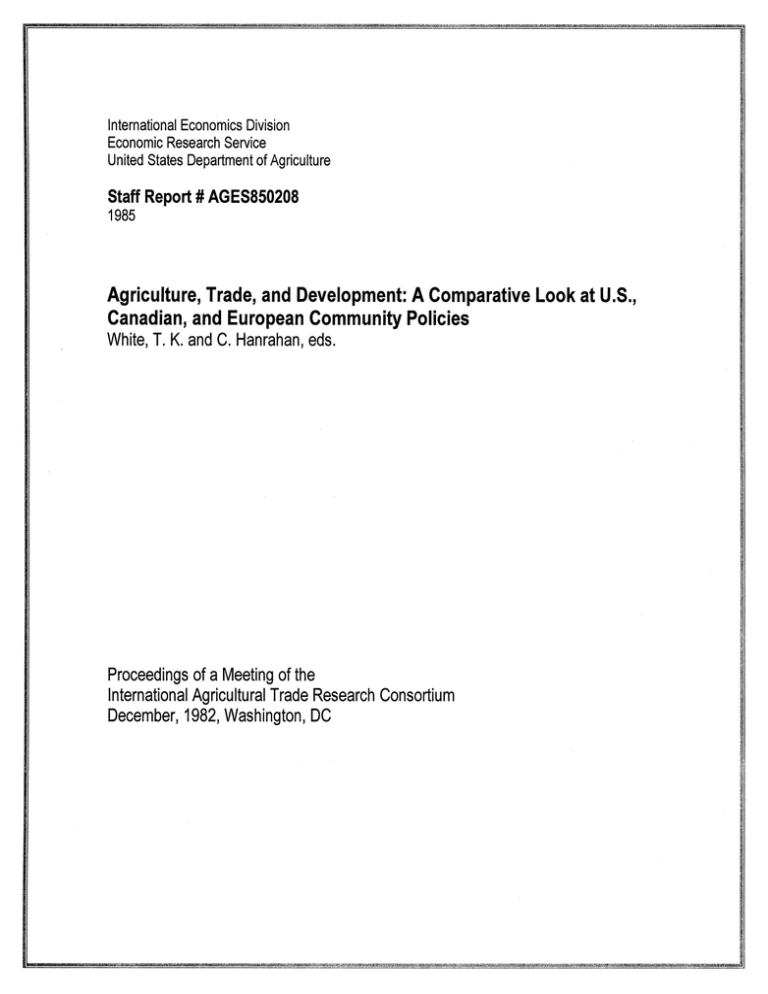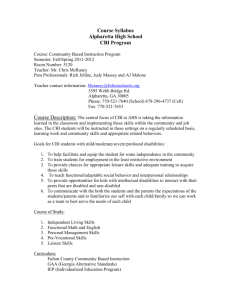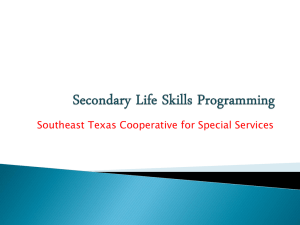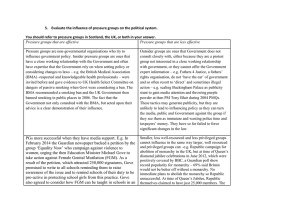International Economics Division Economic Research Service
advertisement

"ryp~
M
{,:~
International Economics Division
Economic Research Service
United States Department of Agriculture
Staff Report # AGES850208
1985
Agriculture, Trade, and Development: A Comparative Look at U.S.,
Canadian, and European Community Policies
White, T. K.and C. Hanrahan, eds.
Proceedings of a Meeting of the
International Agricultural Trade Research Consortium
December, 1982, Washington, DC
igl
....
........
_
RELATIONS WITH THE THIRD WORLD: VIEWS ON THE NORTH-SOUTH
DIALOGUE AND FOOD SECURITY.
The United States
Charles E. Hanrahan
U.S. economic policy toward the Third World derives from U.S. concerns with
the global economy as it affects U.S. economic interests and with promoting
our national security interests. The developing countries are economically
important to the United States and to the other developed countries. In 1970,
the developing countries accounted for around 30 percent or $13 billion of
U.S. exports. Today, these countries account for 37 percent or some $80
billion. The United States exports more to the developing countries than to
Europe and Japan combined. More importantly, the developing countries have
the potential for further increases. U.S. investment in the developing
countries increased from $19 billion in 1970 to over $50 billion in 1980.
There are many developing countries that are important to the United States by
reason of their strategic location, resource endowment, or political
leadership. Further, the United States has a humanitarian interest in
assisting the poor countries to improve their nutrition, health, education,
and housing.
U.S. Economic Objectives Toward the Third World
Statements outlining present U.S. goals and objectives toward the Third World
are contained in the President's remarks to the World Affairs Council in
Philadelphia (October 1981) and in his opening statement to participants in
the International Meeting on Cooperation and Development held in Cancun,
Mexico 1 week later. In both these statements the President laid down the
U.S. view on how the developed countries can best assist the Third World to
achieve economic development and, among other things, food security.
A Cooperative Strategy for Global Growth:
Five Principles
1. Stimulating international trade by opening markets with individual
countries and among countries;
2. Tailoring development strategies to the specific needs and potential of
individual countries and regions;
3. Guiding U.S. assistance toward development of self-sustaining, productive
activities, particularly in food and energy;
4. Improving the climate for private capital flows and technology transfer;
and
5.
Creating a political atmosphere in which practical solutions can move
forward ... (without) policies that restrain and interfere with the
international market place or foster inflation.
Trade and Access to Markets. U.S. trade policy toward the third world is
strongly influenced by both economic and political considerations just as is
U.S. trade policy toward the developed countries or the centrally planned
economies. The United States has long maintained that its own economic and
148
political interests and those of Third World countries would best be served by
integrating the developing countries into the world trading system.
In accord with this principle, in trade as in other aspects of international
economic affairs, the United States has insisted upon the role of the existing
international institutions and their "competence" to deal with international
economic problems rather than the creation of new institutions to solve
economic problems. As the international financial crisis has deepened, U.S.
support for the International Financial Institutions (IFIs) seems to have
strengthened, for example, Treasury Secretary Regan, quoted in a recent
Washington Post article, spoke out in favor of strengthening the hand of the
International Monetary Fund in meeting the credit needs of the developing
countries.
One means of integrating developing countries into the world trading system
has been the granting of preferred access to their exports. The United States
continues to adhere to the principle of "differential and more favorable
treatment" for the majority of developing countries. This policy of
preferential access to the U.S. market by developing countries is implemented
through the Generalized System of Preferences (GSP), under which $7.3 billion
in developing country exports entered the United States duty free during
1980. This amount includes about $1.2 billion in agricultural products.
Access under GSP is limited by mandatory "competitive needs" tests that
protect U.S. industry from excessive competition from third world imports. A
competitive needs test is triggered when the dollar value of imports in a
tariff category exceeds a certain dollar amount (currently $50.9 million) or
when a single country supplies more than 50 percent of an item. Thus, as of
1980, preferences previously accorded to GSP beneficiaries on 29 products
worth $510 million were lifted. In addition, there are procedures whereby
U.S. interests may petition the Office of the Special Trade Representative to
modify the list of eligible products.
The principle of favorable treatment and preferential access is also modified
by the notion of "graduation". During the Tokyo Round of multilateral trade
negotiations and in the recently concluded GATT ministerial, the United States
insisted upon a greater degree of reciprocity in trade relations from the
newly industrializing developing countries (NICs).
As the Congress moves in 1984 to consider the extension of GSP, "graduation"
and competitive needs will likely become a more important criteria for the
inclusion of countries and products receiving preferential treatment.
Private Investment. The U.S. commitment to private investment as a source of
capital for development is unflagging even as the debt crisis in the third
world deepens. Commercial lending and private investment should be fostered
by developed and developing countries alike. Cofinancing of projects by the
IFIs and private commercial banks, expanded activity by the International
Finance Corporation (IFC), and the Overseas Private Investment Corporation
(OPIC) are all viewed as means to increase the flow of capital to the Third
World. Investment and tax policies in developed and developing countries
alike should not impede private capital flows.
149
Development Assistance:
Food and Energy.
Food. For some time, the major emphasis in our foreign assistance program has
been on food and agriculture. Since 1975, more than half of the U.S. foreign
economic and technical assistance has been devoted to food and nutrition
activities under Section 103 of the Foreign Assistance Act (FAA). In the food
and agricultural area, the main emphasis has been on technical assistance in
agricultural research, education, and technology, not on resource transfers.
Land-grant universities, under Title XII of the FAA, are playing an increasing
role in the actual implementation of U.S. agricultural technical assistance
programs. Recently, the United States has been insisting, as does the
International Monetary Fund (IMF) in its lending, on food policy reform,
especially price-policy reform in recipient countries ahead of or in
conjunction with the provision of assistance.
Food aid is an important component of U.S. economic assistance.
Energy. As with food, the U.S. bilateral assistance program stresses
technical assistance, not resource transfers. Multilateral lending, though
not a special facility for energy development, is supported by the United
States, provided projects are economically viable and involve the private
sector.
Development Strategy--The CBI. A fourth principle, tailoring U.S. development
strategy to the needs and potentials of individual countries or regions, is
best illustrated by the President's Caribbean Basin Initiative (CBI). The CBI
is a good illustration of U.S. policy and program for a number of reasons.
First, it indicates how trade, aid, and private investment are supposed to
work together to accomplish U.S. policy objectives in the Third World.
Second, it illustrates the importance of political and national security
considerations in U.S. economic policy toward Third World countries. Third,
the difficulties confronted in Congress by the CBI demonstrate rather
strikingly the influence that domestic economic interests can have on U.S.
foreign economic policy.
The CBI, announced by the President in February, in an address to the
Organization of American States, contains three major elements: a set of
free-trade provisions (the so-called Free Trade Arrangement, or FTA), measures
to encourage investment primarily through tax incentives, investment
guarantees, and development assistance.
The Free Trade Arrangement (FTA)
Originally the free trade provisions of the CBI were to extend to Caribbean
Basin countries, for a period of 12 years, across-the-board, duty-free
treatment for all products with the exception of textiles and apparel.
Although the CBI is a program distinct from the GSP, the same or similar
modifications that have been made in GSP are included in the CBI. Safeguards,
in the form of competitive-needs tests, are available to modify duty-free
access when imports cause or threaten to cause serious injury to a U.S.
domestic industry and its workers. Rules of origin under the FTA are the same
as in the GSP except that the requirement for a minimum percentage of local
value added is reduced from 35 to 25 percent. As proposed by the President,
sugar would have entered under GSP provisions.
Three Basin countries excluded
from GSP--the Dominican Republic, Guatemala, and Panama--would be subject to
duty-free, absolute quotas.
150
Possibilities for more favorable treatment of textiles, apparel, and meats
were originally discussed but are not included in the CBI.
Measures to Encourage Investment
The CBI seeks congressional authorization to grant incentives to U.S.
investors in the region. Specifically, the administration is seeking
incentives in the form of a tax credit of up to 10. percent of the amount of
fixed-asset investment in Caribbean countries. The tax credit would be
granted for a 5-year period, and the credit would permit U.S. firms to reduce
their net tax liability in the United States. The CBI would also enable the
Export-Import Bank to extend guarantees for short-term credit between U.S.
banks, exporters, and local commercial banks in the region.
The CBI also encompasses measures to strengthen the private sector's ability
to exploit CBI created opportunities. One aspect of this would take the form
of task forces to design private sector development strategies for each
country, and Which combine the resources of private, public, and voluntary
organizations. These efforts to strengthen the private sector would include
support for: regional trading companies, assistance in complying with U.S.
health and sanitary regulations, improving transportation links, and training
workers in appropriate skills.
Development Assistance
The administration requested $350 million in supplemental Economic Support
Funds (ESF) in FY 1982 primarily for El Salvador, Costa Rica, and Jamaica. In
addition, beginning in FY 1983 and continuing for a 3- to 4-year period, the
United States would provide an annual $250 million increase in aid to help
countries "revive agricultural and industrial production and create
employment."
The Free Trade Arrangement of the CBI raised, of course, the greatest concerns
on the part of U.S. interests. In Congress, proposed exemptions to the list
of items to receive preferential treatment grew to include sugar and rum, in
addition to the already excluded textiles and apparel. The tax and investment
incentives intended to reduce the economic risks of producing and marketing in
the Caribbean countries also have come under criticism. The only element of
the CBI which has been enacted into law in FY 1982 is the $350 economic- and
technical-assistance component of the package.
Caribbean nations responded, on the whole, positively to the CBI, as reflected
for example, in the views of CARICOM leaders who found many elements of
congruence between Caribbean views and the CBI. However, the Caribbean
nations desire more in the way of capital investment for infrastructure than
is contained in the program.
U.S. Policy Options Toward the Third World
Trade Policy. The basic tendencies in U.S. trade policy toward Third World
countries are likely to persist during the eighties. The GSP, which expires
in 1983, is likely to be continued for the exports of the relatively lowincome Third World countries. If the pace of economic recovery is slow, and
by growing protectionist sentiment, the continuation of GSP could, however, be
jeopardized.
151
There is little likelihood that the United States will respond positively to
Third World, primary producers' desires for international commodity agreements
(ICAs). The developing countries argued their interests in ICAs at Cancun,
but these arguments were largely ignored. Even it appears, UNCTAD VI, held in
Gabon in 1983, has assigned a lower priority to commodity negotiations,
focusing instead on service trade and investment issues.
The U.S. policy of open trade will not likely be applied to sugar and
textiles. The U.S. market for sugar is protected by a combination of a
tariff, a Section-22 fee, and quotas. These bring imported sugar prices to
levels of price support prescribed for sugar in the 1981 farm legislation.
Sugar interests in the southern and western United States are unlikely to give
in on this issue. There is also little prospect for trade liberalization in
textiles. During the negotiations for a new Multifiber Arrangement (MFA) in
1981, the United States did take a more liberal stance than did the EC with
respect to imports of textiles from the developing countries. Ultimately,
however, U.S. textile interests succeeded in getting restrictions on the rate
of growth of imports and the new MFA, which expires in June of 1985, is even
more restrictive than the previous one.
Development Assistance. It is unlikely that U.S. foreign aid will increase
substantially in the foreseeable future. There is one bright spot in U.S. aid
policy for those Third World countries heavily dependent on official
development assistance (ODA) for their economic development which comes from
applying the principal of graduation to aid giving. That is, the reallocation
of foreign aid as resources are shifted from the NICS to the ODA dependent
countries. This seems to be happening as development assistance in the Agency
for International Development (AID) being allocated to many poor African
countries, is increasing. (The World Bank is doing something similar within
the International Development Agency (IDA) lending.)
A foreign-development assistance program, which emphasizes agricultural
development through the provision of technical assistance by the land-grant
universities and agricultural consulting firms, is also likely to persist.
Private Investment. The United States will probably continue to emphasize the
role of private investment in contrast to aid. I have already mentioned
efforts to enhance the role of the IFC and OPIC. The United States is also
exploring means to encourage cofinancing of projects. One such means is
eliminating the 10 percent-of-assets limit on commercial loans cofinanced by
the World Bank and private commercial banks. Another example of the emphasis
given to private investment is the U.S. committee on Jamaican investment,
organized by David Rockefeller at the request of the President as part of the
CBI.
U.S. Policy on Food Security
U.S. views on food security are unlikely to change significantly. The United
States will continue to be the world's main supplier of food aid and will at
least keep its minimum pledge of 4.47 million tons under the 1980 Food Aid
Convention. The United States is unlikely to moderate its opposition to
internationally controlled or coordinated grain reserves, but it strongly
supports the creation of individual country-reserve systems and where
appropriate regional, food security arrangements. The United States supported
and continues to support the extension of the IMF's Compensatory Finance
Facility to cover balance of payments problems resulting from increased food152
import costs due to domestic production shortfalls or sharp increases in the
prices of imported food. One policy option open to the United States
currently is to increase the amount of food available through P.L. 480,
subject of course to international rules regarding the disposition of
surpluses and the constraint imposed by the Federal budget.
Research on U.S. Third World Economic Relations
As noted, the U.S. GSP expires next year. We need to know much more about the
effects of GSP on the exports of Third World countries and on U.S. trade,
employment, and income. Not only do we need empirical analysis of GSP but
also of the Free Trade Arrangement proposed for the Caribbean Basin Initiative.
The Generalized System of Preferences Eliminating Trade Distortions in the NICs
As mentioned above, the United States seeks to integrate the developing
countries into the world trading system and seeks also to apply the principles
of graduation and reciprocity to the NICs. It is important to identify and
measure the effects of trade restricting policies in these countries on our
exports. Trade barriers in the NICs should be examined carefully and models
developed to estimate the effects of their removal. This is particularly
important with respect to agricultural trade to those countries. Among the
trade-distorting measures analyzed, should be exchange-rate regimes and the
effects of liberalizing them.
Market Development
The United States is looking to markets in the Third World as a source of
growth for agricultural and other exports. Thus, the role of developing
countries as importers requires research attention. We need to enhance our
understanding of the relationship between imports from the United States and
development strategy, patterns of development, income, investment strategy,
and exports. Related to this is research to investigate the effectiveness of
U.S. export promotion activities compared to those of our major competitors.
Foreign Private Investment. U.S. policy toward Third World countries places
great emphasis on private investment as a source of development capital. Yet
both the United States and developing countries themselves impose performance
requirements on U.S. firms investing abroad. The effects of these
requirements on trade, income, and employment in the United States and in the
developing countries needs to be assessed. Needed also are analyses of ways
to negotiate reductions or elimination of performance requirements in the
developing countries. (Information on negotiating strategies for reducing
trade distortions in developing countries is also a serious need.) The
conditions in the developing countries--levels of income, levels of education,
and labor skills--that influence investment also need to be identified and
analyzed.
153



